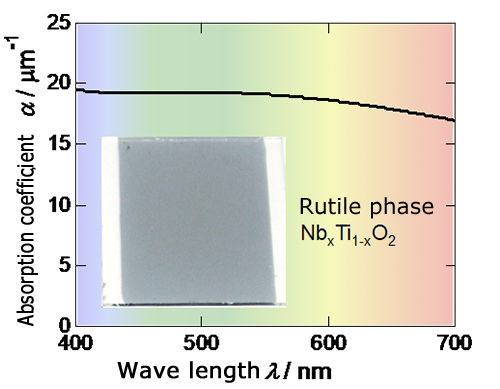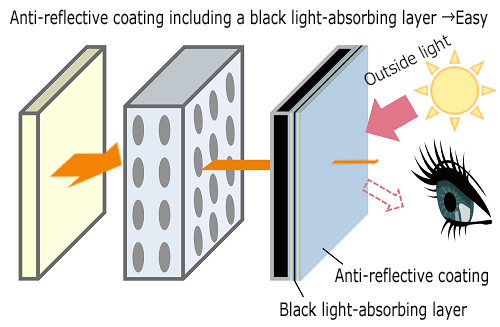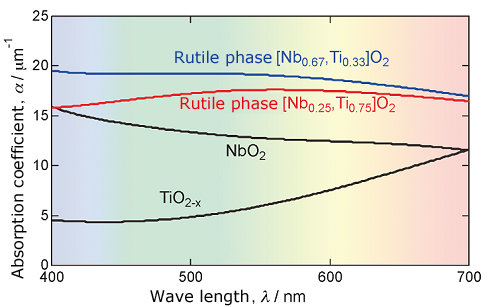[Highlights]
- Researchers have developed new optical thin films with a large and constant absorption coefficient throughout the visible range.
- These thin films make black and dark colors appear richer and deeper on the screen.
[Highlights]
[Overview]
A research group consisting of Akihiro Ishii in his third year of the Doctoral Program at the Graduate School of Engineering, Tohoku University (Special Researcher of the Japan Society for the Promotion of Science), and Professor Hitoshi Takamura has conducted international collaborative research with the University of Washington and Nippon Electric Glass Co., Ltd. and developed a black coating material with a large and constant absorption coefficient throughout the visible range of 400–700 nm (Figure 1). This can overcome the drawbacks of liquid crystal displays (LCDs) by increasing the contrast of dark images. Moreover, this coating material can enhance the aesthetics of any display, including organic electro luminescence displays (OELDs).
This study is to be published in the International journal "Applied Surface Science."

Figure 1. External appearance and optical absorption spectrum of the NbxTi1-xO2 black coating material developed in this study
[Research Background and Challenges]
LCDs are not only thin and lightweight but also durable and relatively inexpensive; therefore, they are widely used in daily consumer products, such as TVs, PCs, and smart phones. However, due to the strong backlight bleeding, it is difficult to reproduce high-quality, high-contrast dark images, such as deep black images and night scenes. In order to solve this problem, a system was developed to dim the backlight when displaying black or dark colors, but this raised a need for complex electronic control and resulted in price hikes. Therefore, our research group aimed to reproduce high-quality dark scenes at relatively low costs by applying an anti-reflective coating (Note 1) including a black light-absorbing layer (Figure 2) to the top panel. The coating material developed in this study is expected to reproduce crisp dark images and deep black images when applied to high luminance displays. This coating is also expected to add value by drastically enhancing the aesthetics of OLEDs and other electronic displays since those coated with this material look luxury with deep black color when turned off.
In order to produce this black light-absorbing layer, it is necessary to develop a new black coating material that can largely and constantly absorb light throughout the visible spectrum (400–700 nm). This is because most black coatings have a large absorption coefficient for high-energy blue light but exhibit a low absorption coefficient for low-energy red light. Carbon materials, such as carbon nanotubes, have a large absorption coefficient throughout the visible range because of the surface asperities, but they cannot be used for anti-reflective coatings that should be perfectly flat at the nanoscale. Therefore, it was essential to develop a new material that works on a new principle to have a large and constant absorption coefficient throughout the visible range.

Figure 2. Method developed in this study to reproduce high-quality dark scenes at relatively low costs
[Key Achievements]
We examined the optical absorption properties of various oxide films prepared in reducing atmosphere by using the pulsed laser deposition technique (Note 2) and found that rutile phase niobium titanium dioxide (NbxTi1-xO2) solid solution has a large and constant absorption coefficient throughout the visible range. With a proper composition control, the average absorption coefficient of this material in the visible range can reach 18–19 μm-1 with a deviation of less than 1 μm-1. Moreover, this rutile phase NbxTi1-xO2 thin film can be applied as an anti-reflection coating since it is flat at the nanoscale with a surface roughness of less than 1 nm.
Rutile phase NbxTi1-xO2 can have a large and constant absorption coefficient throughout the visible range mainly because it possesses the high absorption coefficient of reduced titanium dioxide (TiO2-x) for red light and the high absorption coefficient of niobium dioxide (NbO2) prepared in reducing atmosphere for blue light (Figure 3). TiO2-x has a high absorption coefficient for red light because the reduced electrons move relatively freely. On the other hand, NbO2 with reduced band gaps (Note 3) exhibits a relatively high absorption coefficient for blue light. It is assumed that rutile phase NbxTi1-xO2 has a large and constant absorption coefficient in the visible range because it inherits absorption properties from both TiO2-x and NbO2.

Figure 3. Optical absorption spectra of TiO2-x, NbO2, rutile phase NbxTi1-xO2 thin films
[Future Plans]
The rutile phase NbxTi1-xO2 anti-reflective film developed in this study is expected to contribute to producing LCDs that provide deep dark colors at lower costs. This coating is also expected to add value to these displays by enhancing their aesthetics. Moreover, the new method proposed in this study to control optical absorption properties can be applied to a wide range of studies on photo-energy conversion, such as photovoltaic power generation and photothermal conversion. Furthermore, the electron conductivity applications proposed in this study can be used to produce electrodes for all-solid lithium secondary batteries.
[Publication Information]
Title: Large and constant absorption coefficient in NbxTi1-xO2 thin films throughout the visible range
Authors: Adam E. Shimabukuro, Akihiro Ishii, Itaru Oikawa, Yusuke Yamazaki, Masaaki Imura, Toshimasa Kanai, Fumio S. Ohuchi and Hitoshi Takamura
Journal: Applied Surface Science
URL: https://authors.elsevier.com/a/1XinycXa~ofWm
DOI: https://doi.org/10.1016/j.apsusc.2018.09.036
[Glossary]
Note 1. Ant-reflective coating: This is an optical coating that destructively interferes with the light reflecting off the surface to eliminate reflectivity. In general, it is made of alternate layers of high and low refractive index transparent ceramic nanocomposites.
Note 2. Pulsed laser deposition technique: This is a technique to produce nanometer-thick thin films. A high-power pulsed laser beam is applied to thin film materials to ablate the surface (generate plasma) and collect large volumes of plasma to deposit thin films.
Note 3. Band gap: This is a range between the energy band filled with electrons and the conduction band where no electrons exist in a material. When a material absorbs light, the internal electrons cross this band gap.
Links:
Tohoku University (Japanese)
Graduate School of Engineering, Tohoku University (Japanese)